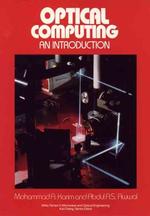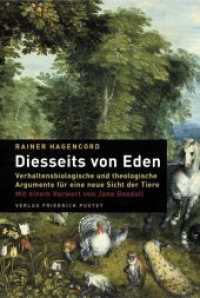- ホーム
- > 洋書
- > 英文書
- > Religion / Ethics
Full Description
In Hermeneutics of Doctrine in a Learning Church, Gregory A. Ryan offers an account of the dynamic, multi-dimensional task of interpreting Christian tradition. He integrates doctrinal hermeneutics, the 'pastorality of doctrine' exemplified by Pope Francis, and a systematic appraisal of Receptive Ecumenism to provide an original perspective on this task. The book focuses on three contemporary Catholic theologians (Francis Schüssler Fiorenza, Ormond Rush, and Paul D. Murray), highlighting how each recognises the dynamic interaction of multiple perspectives involved in authentic ecclesial interpretation.
Christian tradition, whether passed on in teaching, scripture, practices, or structures, needs to be continually received and interpreted. This book offers theologians, ecumenists, and church workers a fresh model for receptive ecclesial learning in which doctrinal hermeneutics and pastoral realities are dynamically integrated.
Contents
Acknowledgements
Abbreviations
1 Disjointed Doctrines, Insistently Imposed?
1.1Introduction
1.2Aim and Objectives
1.3Receptive Integrity
1.4Outline of Chapters
2 No One Thing: Mapping the Dimensions of Doctrinal Hermeneutics
2.1 Introduction
2.2 The Hermeneutics of Doctrine: Anthony C. Thiselton
2.3 Doctrine and Life 13
2.3.1Dispositional Belief
2.3.2Communal Forms of Life
2.3.3Temporality, Narrative, and Drama
2.4 Ecclesial Learning
2.4.1Formation and Training
2.4.2Alterity and Narcissism
2.5 Doctrine and System
2.5.1Dialectic and Polyphony
2.5.2System and Coherence
2.5.3Rescher's Aporetics
2.6 A Catholic Reception of Thiselton
3 Gaudet Mater Ecclesia as a Hermeneutical Lens
3.1 Introduction
3.2 Substance of Faith and Means of Expression
3.3 Paradigmatically Catholic or Hermeneutically Naïve?
3.3.1Reconstruction
3.3.2Retrospection
3.3.3Reception
3.4 The Pastorality of Doctrine
3.4.1Hermeneutical Considerations
3.4.2Pastorality as Expansive, Ecumenical Learning
3.5From Development of Doctrine to a Hermeneutics of Tradition
3.5.1Hermeneutics of Continuity, Rupture, and Reform
3.5.2A Revivified Hermeneutic
3.6 Conclusion
4 Dynamic Integrity and Reflective Equilibrium
4.1 Introduction
4.2 Coherence and Dynamic Integrity: Paul D. Murray
4.3 Broad Reflective Equilibrium: Francis Schüssler Fiorenza
4.4 Reconstructive Hermeneutics and the Integrity of Tradition
4.4.1Identity and Integrity
4.4.2Reconstructive Hermeneutics and Internal Coherence
4.5 Background Theories and Extrinsic Coherence
4.6 Retroductive Warrants and Pragmatic Coherence
4.6.1Hermeneutical Significance
4.6.2Dysfunctions, Wounds, and Incoherence
4.7 Diverse Communities of Discourse and Interpretation
4.8 Conclusion
5 A Vessel Renewed: Reception Hermeneutics and Ecclesial Learning
5.1 Introduction
5.2 Rejuvenating Reception: Ormond Rush
5.3 The Architecture of Reception: Diverse Objects, Sites, and Readings
5.3.1Two Basic Hermeneutical Triads
5.3.2Four Objects of Reception
5.3.3Twelve Sites of Reception
5.3.4Further Hermeneutical Triads
5.4 The Dynamics of Reception: Poiesis, Aesthesis, and Catharsis
5.4.1Poiesis and Productive Receptivity
5.4.2Aesthesis, Recognition, and Integrity
5.4.3Catharsis and Receptive Transformation
5.5 Diachronic and Synchronic Plurality
5.5.1An Alternative to Essentialism
5.5.2A Pluralising Hermeneutics
5.5.3Reception and Alterity
5.6 Putting Reception to Work
5.6.1Amoris Laetitia and the 2014-15 Synods
5.6.2The Reception of Amoris Laetitia
5.6.3Hermeneutics, Reception, and Ecumenism
6 Receptive Ecumenism as a Site of Receptive Integrity
6.1 Introduction
6.2 What Is Receptive Ecumenism?
6.2.1Third Wave Ecumenism
6.2.2Humble Realism and Realistic Humility
6.2.3Receptive Renewal as Ecclesial Learning
6.2.4Affective, Cognitive, and Practical
6.2.5Synodal and Transversal Ecumenism
6.2.6A Bold, New Strategy?
6.3 Dynamic Integrity as a Methodological Commitment
6.3.1Committed Pluralism
6.3.2Recursive Fallibilism
6.3.3Expansive Catholicity
6.3.4Coherence-Based Testing
6.3.5Wounds and Dysfunctions
6.4 Receptive Ecumenism as a Hermeneutical Endeavour
6.4.1Receptive Ecumenism and Ecumenical Hermeneutics
6.4.2Receptive Ecumenism and Reception Hermeneutics
6.5 Conclusion
7 Conclusion: Receiving with Dynamic Integrity
7.1 Retrospect
7.2 Prospect
7.3 Doctrinal Hermeneutics in a Franciscan Key
Bibliography
Index








